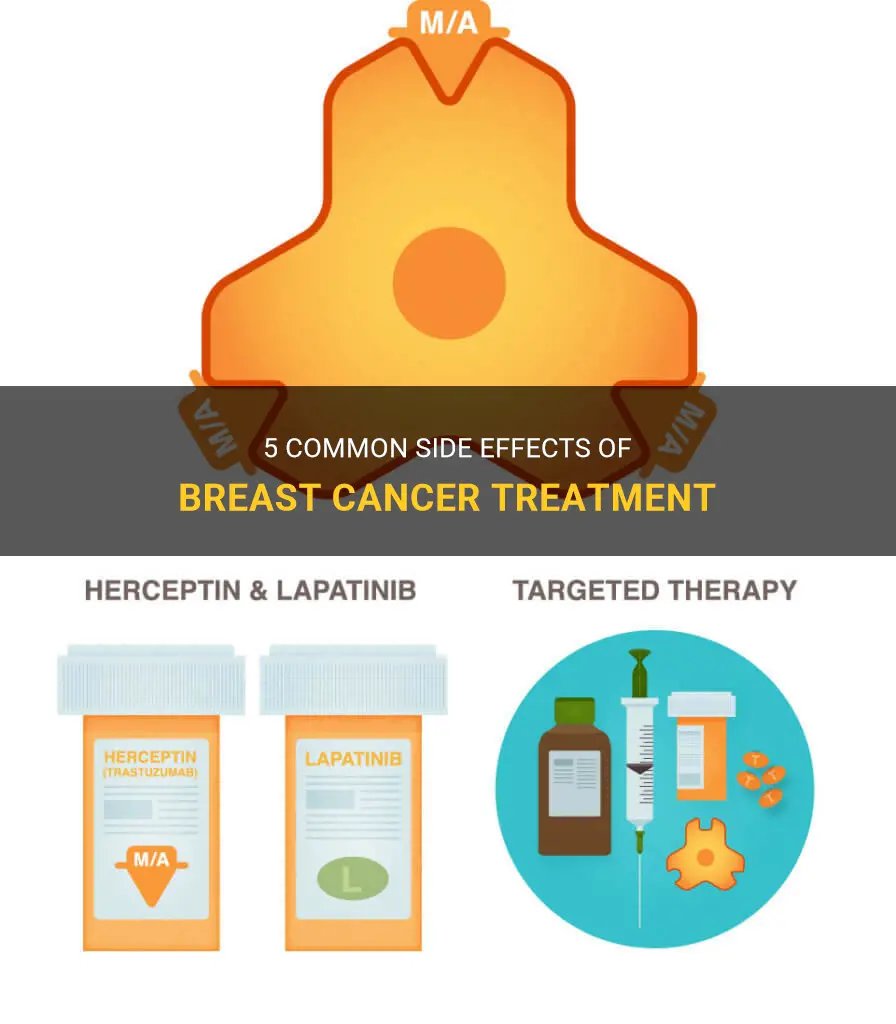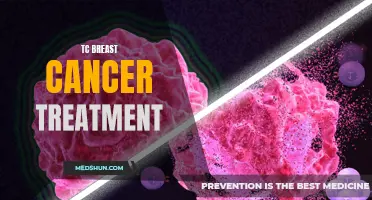
Breast cancer treatment has come a long way in recent years, offering women a better chance of survival than ever before. However, along with the positive outcomes, there are also several potential side effects that can arise from these treatments. From hair loss to fatigue and even changes in body image, the side effects of breast cancer treatment can be difficult to navigate. In this article, we will explore these side effects in more detail, providing you with the tools and information you need to manage them effectively and maintain your quality of life throughout your treatment journey.
| Characteristics | Values |
|---|---|
| Common Side Effects | Fatigue, Nausea, Hair Loss, Pain |
| Gastrointestinal Effects | Nausea, Vomiting, Diarrhea |
| Fatigue | Tiredness, Weakness |
| Hair Loss | Alopecia |
| Pain | Headache, Muscle Pain |
| Cognitive Effects | Memory Loss, Difficulty Concentrating |
| Emotional Effects | Anxiety, Depression |
| Sexual Dysfunction | Loss of libido, Vaginal dryness |
| Cardiovascular Effects | Heart problems, Hypertension |
| Lymphedema | Swelling in limbs |
What You'll Learn
- What are the common side effects of breast cancer treatments?
- How long do the side effects of breast cancer treatment typically last?
- Are there any long-term or permanent side effects from breast cancer treatment?
- What are some strategies or interventions for managing the side effects of breast cancer treatment?
- How can healthcare providers and patients work together to minimize and address the side effects of breast cancer treatment?

What are the common side effects of breast cancer treatments?
Breast cancer is a prevalent disease that affects millions of women worldwide. Thankfully, advancements in medical research have led to various effective treatments for breast cancer. However, like any medical treatment, these interventions can have side effects. It is crucial for patients to be aware of these potential side effects to make informed decisions about their treatment options.
Most breast cancer treatments, such as surgery, radiation therapy, chemotherapy, and hormonal therapy, can cause side effects. The specific side effects experienced by each patient may vary depending on the type and stage of breast cancer, as well as individual factors. Here, we will discuss some common side effects associated with each of these treatments.
Surgery:
- Pain and discomfort: After surgery, patients may experience pain, swelling, and tenderness in the breast and surrounding areas. This discomfort can be managed with medication prescribed by the doctor.
- Scarring: Surgical procedures for breast cancer often leave scars on the breast. While these scars usually fade over time, some may remain more prominent. However, advancements in surgical techniques have minimized scarring in recent years.
- Loss of sensation: Numbness or reduced sensation in the breast and nipple area is a common side effect of breast cancer surgery, particularly in procedures that involve removing the nipple or lymph nodes. This loss of sensation may be temporary or permanent.
Radiation therapy:
- Skin changes: Radiation therapy can cause the skin in the treated area to become red, dry, and itchy. In severe cases, the skin may blister or peel. Proper skincare and the use of recommended creams can help manage these side effects.
- Fatigue: Many patients undergoing radiation therapy experience fatigue, which can range from mild to severe. Proper rest, exercise, and nutrition can help alleviate this symptom.
- Lymphedema: In some cases, radiation therapy can damage the lymphatic system, leading to lymphedema. This condition causes swelling and fluid retention in the arm or breast. Physical therapy and compression garments are often recommended for managing lymphedema.
Chemotherapy:
- Hair loss: One of the most well-known side effects of chemotherapy is hair loss. This occurs because chemotherapy drugs target rapidly dividing cells, which include hair follicles. Hair loss can be temporary or permanent, depending on the drugs used and the individual's response.
- Nausea and vomiting: Chemotherapy drugs can cause nausea and vomiting, which can be managed with anti-nausea medications prescribed by the doctor. Eating small, frequent meals and avoiding strong smells can also help.
- Fatigue and weakened immune system: Chemotherapy can lead to fatigue and a weakened immune system, making patients more susceptible to infections. Rest, a balanced diet, and precautions to minimize exposure to pathogens are crucial during this time.
Hormonal therapy:
- Menopausal symptoms: Certain hormonal therapies, such as aromatase inhibitors, can induce menopausal symptoms such as hot flashes, night sweats, and vaginal dryness. These symptoms can be managed with hormone replacement therapy or other medications.
- Joint and muscle pain: Some patients may experience joint and muscle pain while undergoing hormonal therapy. Gentle exercise, physical therapy, or pain relievers recommended by the doctor may help alleviate this discomfort.
These are just a few examples of the common side effects associated with breast cancer treatments. It is important to note that not all patients will experience these side effects, and their severity may vary. It is crucial for patients to discuss potential side effects with their healthcare team and to report any changes or concerns promptly. Medical professionals can provide personalized advice and interventions to help manage these side effects and improve the overall treatment experience for breast cancer patients.
Understanding Breast Cancer Treatment Options in India
You may want to see also

How long do the side effects of breast cancer treatment typically last?
Breast cancer treatment can cause a variety of side effects, which can last varying lengths of time depending on the specific treatment and individual factors. While certain side effects may resolve shortly after treatment ends, others may persist for months or even longer. It is important for patients to have a realistic understanding of potential side effects and to discuss their concerns with their healthcare team.
Chemotherapy is a common treatment for breast cancer, and its side effects can be experienced during treatment and for some time afterward. Some common side effects of chemotherapy include fatigue, hair loss, nausea, and changes in appetite. These side effects typically improve within a few weeks to a few months after treatment ends. However, some effects such as hair loss may take longer to resolve, and some patients may experience long-term effects such as nerve damage or fertility issues.
Radiation therapy is another common treatment for breast cancer, and its side effects can also vary in duration. Immediately after treatment, patients may experience skin irritation, redness, and soreness in the treatment area. These side effects generally improve within a few weeks to a couple of months. However, some patients may develop long-term side effects such as changes in skin pigmentation or lung damage, although these are less common.
Hormone therapy is often used in breast cancer treatment, particularly for hormone receptor-positive tumors. The side effects of hormone therapy can include hot flashes, joint pain, and mood swings. Some women may experience these side effects for the duration of their treatment, while others may find that they improve over time. It is important for patients to discuss any persistent side effects with their healthcare team, as alternative therapies or strategies may be available to manage them.
Surgery is a common component of breast cancer treatment, and it can also have side effects that last for varying lengths of time. Immediately after surgery, patients may experience pain, swelling, and limited arm mobility. These side effects generally improve within a few weeks, although some patients may experience long-term arm or chest wall discomfort. Breast reconstruction can also have its own set of side effects, including pain, swelling, and changes in sensation, which can last for several months.
In addition to the physical side effects, breast cancer treatment can also have emotional and psychological effects that may persist long after treatment ends. Many patients experience anxiety, depression, or fear of recurrence. It is important for patients to seek support from loved ones, support groups, or mental health professionals to help manage these emotional effects.
It is important to note that every individual is unique, and the duration and severity of side effects can vary greatly. It is essential for patients to communicate openly with their healthcare team about their concerns and experiences. The healthcare team can provide valuable guidance and support, and they may be able to offer strategies to manage side effects or referral to additional resources if needed. With proper care and support, many individuals are able to recover from breast cancer treatment and resume their normal lives.
Understanding the Standard Treatment for Triple Positive Breast Cancer
You may want to see also

Are there any long-term or permanent side effects from breast cancer treatment?
Breast cancer is a devastating disease that affects millions of women worldwide. Fortunately, advances in medical technology and treatment options have greatly improved survival rates for breast cancer patients. However, many patients wonder if there are any long-term or permanent side effects from breast cancer treatment.
The answer to this question is complex and depends on various factors, including the type and stage of breast cancer, the specific treatments utilized, and the individual patient's overall health. While some side effects may be temporary, others can have long-lasting effects on a woman's physical and emotional well-being.
Surgery is often the first line of treatment for breast cancer, and it can have both short-term and long-term side effects. Immediately following surgery, patients may experience pain, swelling, and limited mobility in the affected area. These symptoms typically resolve within a few weeks to a few months. However, some women may also experience chronic pain or discomfort, changes in breast shape or size, or restricted range of motion.
Another common treatment for breast cancer is radiation therapy, which uses high-energy beams to kill cancer cells. While radiation therapy can effectively target cancer cells, it can also damage healthy cells in the area being treated. This can lead to side effects such as fatigue, skin changes, and swelling. In rare cases, radiation therapy may cause long-term complications, including tissue fibrosis, lymphedema, or an increased risk of developing other types of cancer.
Chemotherapy is another treatment option for breast cancer. Chemotherapy drugs are designed to kill rapidly dividing cancer cells, but they can also affect healthy cells in the body. As a result, chemotherapy often causes side effects such as fatigue, hair loss, nausea, and vomiting. In some cases, chemotherapy can also cause long-term damage to the heart, kidneys, or nervous system.
Hormonal therapy is commonly used to treat breast cancer that is hormone receptor-positive. This type of therapy works by blocking the effects of estrogen, which can fuel the growth of breast cancer cells. While hormonal therapy is generally well-tolerated, it can have side effects such as hot flashes, weight gain, and mood swings. In rare cases, long-term hormonal therapy may increase the risk of osteoporosis or blood clots.
In addition to these treatment-specific side effects, breast cancer survivors often face emotional and psychological challenges. Many women experience anxiety, depression, or fear of recurrence. Some may also struggle with body image issues, especially if they have had a mastectomy or other surgical procedures. It is important for breast cancer patients and survivors to receive support and counseling to address these emotional and psychological issues.
In conclusion, breast cancer treatment can have both short-term and long-term side effects. While some side effects may be temporary and resolve with time, others can have long-lasting effects on a woman's physical and emotional well-being. It is important for patients and survivors to discuss potential side effects with their healthcare team and seek appropriate support to mitigate these effects. With proper care and support, women can live fulfilling lives after breast cancer treatment.
Exploring Kelly Preston's Journey: An Insight into Her Breast Cancer Treatment
You may want to see also

What are some strategies or interventions for managing the side effects of breast cancer treatment?
Breast cancer treatment often comes with various side effects that can impact a woman's quality of life. However, there are several strategies and interventions that can help manage these side effects and improve overall well-being during treatment. Here are some effective approaches:
- Fatigue management: Fatigue is a common side effect of breast cancer treatment. To manage fatigue, it is important for patients to prioritize rest and engage in regular physical activity. Gentle exercises like walking or yoga can help boost energy levels. Adequate sleep, a balanced diet, and stress reduction techniques such as deep breathing and meditation can also contribute to reducing fatigue.
- Nausea and vomiting management: Chemotherapy and radiation therapy can often cause nausea and vomiting. Anti-nausea medications, known as antiemetics, can be prescribed by the healthcare team to help manage these symptoms. Additionally, eating small, frequent meals and avoiding strong odors can help alleviate nausea. Staying hydrated and trying complementary therapies such as acupuncture or ginger supplements may also provide relief.
- Pain management: Breast cancer treatment can result in various types of pain, including surgical pain, nerve pain, or joint pain caused by certain medications. Pain management can involve a multidisciplinary approach, including medications (such as opioids or nonsteroidal anti-inflammatory drugs), physical therapy, and alternative therapies like massage or acupuncture. It is important for patients to communicate their pain levels to their healthcare team so that appropriate interventions can be implemented.
- Radiation dermatitis management: Radiation therapy can cause skin irritations, known as radiation dermatitis. To manage this side effect, patients are advised to keep the skin clean and moisturized using fragrance-free, gentle products. Avoiding exposure to extreme temperatures, wearing loose-fitting clothing, and protecting the treated area from direct sunlight are also important. In some cases, specialized dressings or creams may be prescribed to ease symptoms.
- Lymphedema management: Lymphedema is a condition characterized by swelling in the arms or chest following surgery or radiation that affects the lymph nodes. To manage lymphedema, patients may be referred to a lymphedema therapist who can provide manual lymphatic drainage, compression bandaging, and exercises to reduce swelling and improve lymph flow. Wearing fitted compression garments, avoiding trauma to the affected area, and practicing good skincare can also prevent or minimize lymphedema.
- Emotional support and counseling: Breast cancer treatment can be emotionally challenging, leading to feelings of anxiety, depression, or mood swings. Seeking emotional support and counseling can help patients cope with these emotional side effects. Support groups, therapy sessions, or online communities can provide a safe space for patients to share their experiences, learn coping techniques, and seek advice from others who have gone through a similar journey.
It's important to note that each person's experience may differ, and not all interventions may be appropriate for everyone. It is crucial for patients to discuss their specific side effects and concerns with their healthcare team to develop personalized strategies for managing side effects and improving overall well-being during breast cancer treatment.
Understanding the Impact of Radiation Treatment on Driving Ability after Breast Cancer
You may want to see also

How can healthcare providers and patients work together to minimize and address the side effects of breast cancer treatment?
Breast cancer treatment often involves a combination of surgery, radiation therapy, chemotherapy, hormone therapy, and targeted therapy. While these treatments are crucial for eliminating cancer cells and preventing recurrence, they can also have side effects that can significantly impact a patient's quality of life. To minimize and address these side effects, healthcare providers and patients must work together closely throughout the treatment process.
Education and Communication:
One of the first steps in minimizing and addressing side effects is to ensure that both healthcare providers and patients have a clear understanding of the potential side effects of treatment. This can be achieved through education sessions, informational materials, and open communication between the patient and their healthcare team. Patients should feel comfortable discussing any concerns or symptoms they may be experiencing, as early intervention can often prevent side effects from worsening.
Personalized Treatment Plans:
Every individual's experience with breast cancer treatment is unique, and healthcare providers must take this into account when developing a treatment plan. By considering factors such as the patient's age, overall health, and personal preferences, healthcare providers can tailor treatment regimens to minimize the risk of certain side effects. For example, older patients may be more prone to certain side effects and may require adjustments to their treatment plan to reduce these risks.
Multidisciplinary Approach:
Breast cancer treatment often involves a team of healthcare professionals, including surgeons, oncologists, radiologists, and nurses. This multidisciplinary approach ensures that all aspects of a patient's care are addressed, including the management of side effects. By working together, these professionals can develop comprehensive treatment plans that incorporate strategies to prevent and address side effects. For example, a radiation oncologist may collaborate with a dermatologist to develop a skincare routine for patients undergoing radiation therapy.
Supportive Care:
In addition to the medical aspects of treatment, healthcare providers should also focus on providing supportive care to patients. This can include services such as psychological counseling, nutrition counseling, pain management, and physical therapy. By addressing the physical, emotional, and psychological needs of patients, healthcare providers can help minimize the impact of side effects and improve overall well-being.
Patient Education and Self-Management:
Patients also play a crucial role in minimizing and addressing side effects. By educating themselves about their treatment and potential side effects, patients can take proactive steps to manage these side effects. For example, learning about the importance of skincare during radiation therapy can help patients prevent skin irritation and other dermatological side effects. Additionally, patients should be encouraged to practice self-care techniques, such as exercise, relaxation, and stress management, which can help alleviate side effects and improve overall well-being.
Follow-Up and Monitoring:
Regular follow-up appointments and monitoring are essential for detecting and addressing side effects early on. Healthcare providers should schedule regular check-ins with patients to assess their overall health, manage side effects, and make any necessary adjustments to the treatment plan. For example, if a patient is experiencing severe nausea and vomiting as a side effect of chemotherapy, their healthcare provider may prescribe anti-nausea medications or adjust their chemotherapy regimen.
In conclusion, minimizing and addressing the side effects of breast cancer treatment requires a collaborative effort between healthcare providers and patients. Through education, personalized treatment plans, a multidisciplinary approach, supportive care, patient education, and regular follow-up, healthcare providers and patients can work together to manage and alleviate side effects, ultimately improving the patient's quality of life during and after treatment.
Frequently asked questions
Common side effects of breast cancer treatment can vary depending on the type and stage of treatment. However, some common side effects include fatigue, hair loss, nausea and vomiting, changes in appetite or weight, and skin changes. Additionally, some treatments may cause temporary or long-term effects such as infertility, menopausal symptoms, or heart problems. It is important to discuss potential side effects with your healthcare team before starting treatment and to communicate any concerns or symptoms throughout the process.
Fatigue is a common side effect of breast cancer treatment and can range from mild to severe. To manage fatigue, it is important to prioritize self-care and conserve your energy. This can involve getting plenty of rest, napping when necessary, and pacing yourself throughout the day. It may also be helpful to engage in light exercise or physical activity, as this has been shown to combat fatigue. Additionally, eating a healthy diet, staying hydrated, and seeking support from loved ones can help manage fatigue during treatment.
Hair loss is a common and distressing side effect of certain breast cancer treatments, such as chemotherapy. While not all treatments cause hair loss, there are some strategies that can help minimize the impact if hair loss does occur. Options include using cooling caps or scalp cooling systems during chemotherapy to reduce blood flow to the hair follicles, which can help preserve hair. Additionally, some people choose to wear wigs, scarves, or hats to cover their hair loss, while others embrace their baldness and choose not to cover up. Discussing your options with your healthcare team and connecting with support groups or organizations that specialize in hair loss during cancer treatment can provide valuable guidance and support.







